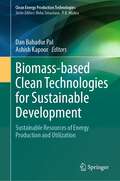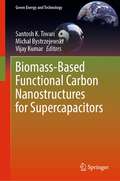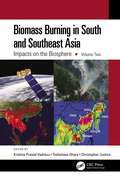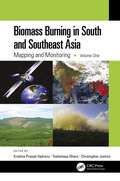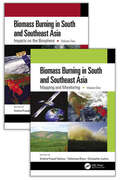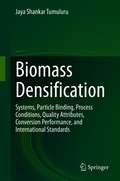- Table View
- List View
Biomass and Solar-Powered Sustainable Digital Cities
by O.V. Gnana Swathika K. Karthikeyan Milind Shrinivas Dangate Nicoletta RavasioWritten and edited by a team of experts in the field, this groundbreaking new volume from Wiley-Scrivener offers the latest trends, processes, and breakthroughs in biomass and solar-powered technologies aimed at marching toward sustainable digital cities. This exciting new volume includes the research contribution of experts in solar and biomass-powered digital cities, incorporating sustainability by embedding computing and communication in day-to-day smart city applications. This book will be of immense use to practitioners in industries focusing on adaptive configuration and optimization in smart city systems. A wide array of smart city applications is also discussed with suitable use cases. The contributors to this book include renowned academics, industry practitioners, and researchers. Through case studies, it offers a rigorous introduction to the theoretical foundations, techniques, and practical solutions in this exciting area. Building smart cities with effective communication, control, intelligence, and security is discussed from societal and research perspectives. Whether for the veteran engineer, new hire, or student, this is a must-have volume for any library.
Biomass as Raw Material for the Production of Biofuels and Chemicals
by Waldemar WójcikFor the power industry, biomass is just a modern name for the ancient material of plant origin that was converted into energy in the simple technology of burning. This book discusses biomass as a raw material for the production of liquid or gaseous biofuels and valuable chemicals. Such biomass processing should be beneficial from both economic and environmental points of view. Classic technologies of biogas production are still being improved, but they always generate waste that differs in terms of chemical parameters, depending on the feedstock digested. These parameters dictate the manner of their final managing. Various biotechnologies allow the use of the biomass of hydrobionts, such as cyanobacteria as a raw substance for obtaining different products, e.g. hyaluronic acid, biopolymers, fertilizers, or even drugs. Animal fats or algae can be used to produce biodiesel which in turn is used in environmentally friendly urban transport. Even municipal solid waste can be a source of useful biomass. The authors show how its volume and composition can be predicted, by which form of processing it can be converted into valuable products, as well as in which ways its negative environmental impact can be limited.
Biomass as Raw Material for the Production of Biofuels and Chemicals
by Waldemar Wójcik Ma 322 Gorzata Paw 322 OwskaFor the power industry, biomass is just a modern name for the ancient material of plant origin that was converted into energy in the simple technology of burning. This book discusses biomass as a raw material for the production of liquid or gaseous biofuels and valuable chemicals. Such biomass processing should be beneficial from both economic and environmental points of view. Classic technologies of biogas production are still being improved, but they always generate waste that differs in terms of chemical parameters, depending on the feedstock digested. These parameters dictate the manner of their final managing. Various biotechnologies allow the use of the biomass of hydrobionts, such as cyanobacteria as a raw substance for obtaining different products, e.g. hyaluronic acid, biopolymers, fertilizers, or even drugs. Animal fats or algae can be used to produce biodiesel which in turn is used in environmentally friendly urban transport. Even municipal solid waste can be a source of useful biomass. The authors show how its volume and composition can be predicted, by which form of processing it can be converted into valuable products, as well as in which ways its negative environmental impact can be limited.
The Biomass Assessment Handbook: Energy for a sustainable environment
by Frank Rosillo-Calle Peter De Groot Sarah L. Hemstock Jeremy WoodsThe increasing importance of biomass as a renewable energy source has led to an acute need for reliable and detailed information on its assessment, consumption and supply. Responding to this need, and overcoming the lack of standardised measurement and accounting procedures, this best-selling handbook provides the reader with the skills to understand the biomass resource base, the tools to assess the resource, and explores the pros and cons of exploitation. This new edition has been fully updated and revised with new chapters on sustainability methodologies. Topics covered include assessment methods for woody and herbaceous biomass, biomass supply and consumption, land use change, remote sensing techniques, food security, sustainability and certification as well as vital policy issues. The book includes international case studies on techniques from measuring tree volume to transporting biomass, which help to illustrate step-by-step methods. Technical appendices offer a glossary of terms, energy units and other valuable resource data.
The Biomass Assessment Handbook: Energy for a sustainable environment
by Frank Rosillo-Calle Peter De Groot Sarah L. Hemstock Jeremy WoodsThe increasing importance of biomass as a renewable energy source has led to an acute need for reliable and detailed information on its assessment, consumption and supply. Responding to this need, and overcoming the lack of standardised measurement and accounting procedures, this best-selling handbook provides the reader with the skills to understand the biomass resource base, the tools to assess the resource, and explores the pros and cons of exploitation. This new edition has been fully updated and revised with new chapters on sustainability methodologies. Topics covered include assessment methods for woody and herbaceous biomass, biomass supply and consumption, land use change, remote sensing techniques, food security, sustainability and certification as well as vital policy issues. The book includes international case studies on techniques from measuring tree volume to transporting biomass, which help to illustrate step-by-step methods. Technical appendices offer a glossary of terms, energy units and other valuable resource data.
Biomass-based Clean Technologies for Sustainable Development: Sustainable Resources of Energy Production and Utilization (Clean Energy Production Technologies)
by Dan Bahadur Pal Ashish KapoorThis book explores the comprehensive world of biomass-based clean technologies for sustainable development. The meticulously curated book delves into the latest advancements, process and product development aspects, and socio-techno-economic viability of biomass-derived solutions. The book aims to explore cutting-edge strategies and innovative approaches to revolutionize energy and environmental sectors on a global scale. The book covers a wide range of scientific and technological fields, shedding light on the utilization of agricultural and forest-derived biomass. Multifarious applications in biofuels, biochar, natural composites, construction materials, and value-added chemicals are explored. The book is an attempt to impart knowledge to address challenging aspects like feedstock variability, supply chain management, process optimization, product standardization, environmental impact, net carbon footprint, and economic viability. By fostering interdisciplinary collaboration and harnessing the renewable nature of biomass, this book offers a holistic approach to develop novel and sustainable solutions. Researchers, scientists, engineers, and professionals from diverse backgrounds will find this book to be an invaluable resource. Policymakers and industry leaders seeking to drive the adoption of clean and green technologies will gain crucial insights. Students and academics will benefit from the latest advancements in biomass-based clean technologies, process and product development aspects, and sustainability assessments. This book is an essential companion for those dedicated to shaping a greener future and will inspire public-private collaborations and innovative research endeavours.
Biomass-based Cosmetics: Research Trends and Future Outlook
by Widya Fatriasari Enos Tangke Arung Irawan Wijaya Kusuma Harlinda Kuspradini Kuniyoshi Shimizu Yong-Ung Kim Nur Izyan Wan Azelee Zehra EdisThis book highlights the potential of biomass for cosmetics applications. It covers the discussion on biomass as a source for cosmetics from savanna, marine and tropical forest, trend and market outlook of biobased cosmetics, active substances from biomass for cosmetics, extractives from biomass for cosmetics, other non-wood forest products such as essential oil, tengkawang, and bee pollen. Besides that, the potency of biopolymers such as lignin, and polysaccharides are presented. The book also discusses activated carbon as a cosmetic source. To present more comprehensive information, it covers biomass as anti-aging, anti-acne, sunscreen, anti-melanin, and antimicrobial. Regarding the close contact system with the human in daily life, cosmetic needs to comply with the human system. Therefore, one special chapter is dedicated to presenting the compatibility view of biobased cosmetics in the human body system. Nanomaterials in cosmetics have started to be used by many beauty companies asindicated by nano-related patents. The nanotechnology applications in cosmetics also provide future trends in bio-based cosmetics. Some forms of nanomaterials that have been reported include liposomes, nanoemulsion, nanocapsules, solid lipid nanoparticles, nanocrystals, nano-silver, nano-gold, hydrogel, etc. Iodinated Aloe Vera formulations within polymeric complexes present examples of bio-antimicrobials and such compounds are at the crossroads between pharmaceutics and cosmetics. Finally, the environmental and safety impacts of biobased cosmetic development are discussed as the closure in the last chapter.This book is expected to provide insightful information for those dealing with biomass or doing research on biomass for sustainable living. Moreover, it is also suitable for policymakers to get the new and latest information on valorizing local biomass while expanding its usage for cosmeceutical purposes. Due to the current environmental problems occurring in our surroundings, this book is seen to be an important tool to spread awareness of the smart way of utilizing our precious biomass and transforming it into valuable products.
Biomass-Based Functional Carbon Nanostructures for Supercapacitors (Green Energy and Technology)
by Santosh K. Tiwari Michal Bystrzejewski Vijay KumarThis book presents a widespread description of the synthesis and characterization of biomass-based carbon nanostructures. It also covers the vital applications of these materials in supercapacitors and for next-generation energy storage devices. It describes the common design procedures, advantages and disadvantages of biomass-based carbon nanostructures and offers novel visions into the forthcoming directions. In addition, this book will provide new updates about the effect of doping and structural twist on the electrochemical performance of electrode materials derived from biomass sources. The book will be useful for beginners, researchers, and professionals working in the area of carbon nanomaterials and their applications in energy storage devices.
Biomass, Bioproducts and Biofuels
by Jorge M.T.B. VarejãoDue to its depletion and the environmental damage it causes, hydrocarbons are being replaced by energy from renewable sources. One such form of energy source is Biomass. Biomass is a renewable raw material generated by living organisms and found in agricultural waste in large quantities. The three main components of biomass are cellulose, hemicellulose and lignin. The first two components are sugar polymers, being cellulosic ethanol a desirable goal for converting those. The truth is that the production of cellulosic ethanol has never passed the pilot unit phase, due to the lack of economic competitiveness. New ways must be found to make this viable. From the latest finding of the biomass structure, new biomass processing pathways are being advanced, constituting new biorefinery models, which will make it possible to obtain cellulosic ethanol concomitant with the production of different bioproducts such as xylitol, oligosaccharides, antioxidants and analogues to carbon fiber, etc. Lipid rich biomass is the source of foods oils. With population growth, the amounts of waste volume will increase. It is important to improve the processes of valorization of these residues, through their conversion into alcoholic esters of fatty acids, which can be used as fuel or in other domestic and industrial applications. This volume reviews advances and innovative applications in this field. It will encourage the use of new works and even unpublished works to use biomass or its components for the production of bioproducts and biofuels.
Biomass, Bioproducts and Biofuels
by Jorge M.T.B. VarejãoDue to its depletion and the environmental damage it causes, hydrocarbons are being replaced by energy from renewable sources. One such form of energy source is Biomass. Biomass is a renewable raw material generated by living organisms and found in agricultural waste in large quantities. The three main components of biomass are cellulose, hemicellulose and lignin. The first two components are sugar polymers, being cellulosic ethanol a desirable goal for converting those. The truth is that the production of cellulosic ethanol has never passed the pilot unit phase, due to the lack of economic competitiveness. New ways must be found to make this viable. From the latest finding of the biomass structure, new biomass processing pathways are being advanced, constituting new biorefinery models, which will make it possible to obtain cellulosic ethanol concomitant with the production of different bioproducts such as xylitol, oligosaccharides, antioxidants and analogues to carbon fiber, etc. Lipid rich biomass is the source of foods oils. With population growth, the amounts of waste volume will increase. It is important to improve the processes of valorization of these residues, through their conversion into alcoholic esters of fatty acids, which can be used as fuel or in other domestic and industrial applications. This volume reviews advances and innovative applications in this field. It will encourage the use of new works and even unpublished works to use biomass or its components for the production of bioproducts and biofuels.
Biomass Burning in South and Southeast Asia: Impacts on the Biosphere, Volume Two
by Krishna Prasad Vadrevu Toshimasa Ohara Christopher JusticeBiomass burning is one of the most important sources of greenhouse gas emissions and aerosols in South and Southeast Asia and greatly impacts other countries through transboundary air pollution. With contributions from leading scientists, this volume offers an interdisciplinary perspective on the impacts of biomass burning on the land resources, climate, and the atmosphere. It showcases several examples linking top-down remote sensing, bottom-up ground-based measurements, and an integrated modeling to address the impacts of biomass burning and land–atmosphere interactions. It is a valuable guide for readers in atmospheric science, ecology, spatial geography, remote sensing, and GIS. This book is unique as it highlights the sources and the causes of biomass burning and atmospheric research in South and Southeast Asia. It explains the latest tools and techniques, in particular the use of satellite remote sensing and geospatial technologies for fire mapping, monitoring, and land cover/land use change. It focuses on large spatial scales integrating top-down and bottom-up methodologies. It addresses the pressing issues of air pollution rampant in South and Southeast Asia. It includes contributions from global experts working on biomass burning projects in the USA, Japan, South/Southeast Asia, and Europe. The contents of this book will appeal to students and professionals using remote sensing and geospatial techniques, including geographers, ecologists, atmospheric and environmental scientists, and all who are interested in biomass burning pollution.
Biomass Burning in South and Southeast Asia: Mapping and Monitoring, Volume One
by Krishna Prasad Vadrevu Toshimasa Ohara Christopher JusticeVolume 1 of a two volume set, this book is a self-contained, state-of-the-art analysis of remote sensing, ground-based, and spatial techniques used for characterizing biomass burning events and pollution. It is a collective achievement of renowned scientists working throughout South and Southeast Asia. They discuss the complexity of vegetation patterns, biomass characteristics, fire distribution, drivers of fires, and several examples of the use of novel satellite algorithms for mapping and monitoring biomass burning events. The book is highly interdisciplinary and integrates earth science and environmental science including ecology, fire science, spatial geography, remote sensing, and geospatial technologies. Unique in its discussion of the sources and the causes of biomass burning and atmospheric research in South and Southeast Asia. Explains how remote sensing and geospatial technologies help the mapping and monitoring of biomass burning events and their impacts. Focuses on large spatial scales integrating top-down and bottom-up methodologies. Addresses the pressing issues of environmental pollution that are rampant in South and Southeast Asia. Includes contributions from global experts actually working on biomass burning projects in the US, Japan, South/Southeast Asia, and Europe. This book will serve as a valuable source of information for remote sensing scientists, geographers, ecologists, atmospheric scientists, environmental scientists, and all who wish to advance their knowledge on fires and biomass burning in South/Southeast Asia.
Biomass Burning in South and Southeast Asia: Mapping and Monitoring, Volume One
by Krishna Prasad Vadrevu Toshimasa Ohara Christopher JusticeVolume 1 of a two volume set, this book is a self-contained, state-of-the-art analysis of remote sensing, ground-based, and spatial techniques used for characterizing biomass burning events and pollution. It is a collective achievement of renowned scientists working throughout South and Southeast Asia. They discuss the complexity of vegetation patterns, biomass characteristics, fire distribution, drivers of fires, and several examples of the use of novel satellite algorithms for mapping and monitoring biomass burning events. The book is highly interdisciplinary and integrates earth science and environmental science including ecology, fire science, spatial geography, remote sensing, and geospatial technologies. Unique in its discussion of the sources and the causes of biomass burning and atmospheric research in South and Southeast Asia. Explains how remote sensing and geospatial technologies help the mapping and monitoring of biomass burning events and their impacts. Focuses on large spatial scales integrating top-down and bottom-up methodologies. Addresses the pressing issues of environmental pollution that are rampant in South and Southeast Asia. Includes contributions from global experts actually working on biomass burning projects in the US, Japan, South/Southeast Asia, and Europe. This book will serve as a valuable source of information for remote sensing scientists, geographers, ecologists, atmospheric scientists, environmental scientists, and all who wish to advance their knowledge on fires and biomass burning in South/Southeast Asia.
Biomass Burning in South and Southeast Asia: Impacts on the Biosphere, Volume Two
by Krishna Prasad Vadrevu Toshimasa Ohara Christopher JusticeBiomass burning is one of the most important sources of greenhouse gas emissions and aerosols in South and Southeast Asia and greatly impacts other countries through transboundary air pollution. With contributions from leading scientists, this volume offers an interdisciplinary perspective on the impacts of biomass burning on the land resources, climate, and the atmosphere. It showcases several examples linking top-down remote sensing, bottom-up ground-based measurements, and an integrated modeling to address the impacts of biomass burning and land–atmosphere interactions. It is a valuable guide for readers in atmospheric science, ecology, spatial geography, remote sensing, and GIS. This book is unique as it highlights the sources and the causes of biomass burning and atmospheric research in South and Southeast Asia. It explains the latest tools and techniques, in particular the use of satellite remote sensing and geospatial technologies for fire mapping, monitoring, and land cover/land use change. It focuses on large spatial scales integrating top-down and bottom-up methodologies. It addresses the pressing issues of air pollution rampant in South and Southeast Asia. It includes contributions from global experts working on biomass burning projects in the USA, Japan, South/Southeast Asia, and Europe. The contents of this book will appeal to students and professionals using remote sensing and geospatial techniques, including geographers, ecologists, atmospheric and environmental scientists, and all who are interested in biomass burning pollution.
Biomass Burning in South and Southeast Asia, Two Volume Set
by Krishna Prasad Vadrevu Toshimasa Ohara Christopher JusticeThe increasing intensity and frequency of natural disasters all around the world has caused severe socioeconomic impacts, especially in South and Southeast Asia. This region is particularly susceptible to vegetation fires, leading to biomass burning pollution with impacts on other countries through trans-boundary air pollution. Despite the growing body of information on biomass pollutants worldwide, only a modest amount of data from these regions are available. With fires and biomass burning identified as a vital issue in South/Southeast Asia, this two-volume set was created to meet community research and application needs. To better serve the atmospheric, environmental, and remote sensing communities, and to address air quality, climate, and the human health impacts of greenhouse gases and aerosols from biomass burning, this set brings together the collective achievements of experts in these regions and the state-of-the-art technologies and spatial analyses to model and monitor biomass burning events and their impacts. This first volume covers various topics on fire, biomass burning, mapping and monitoring while the second volume highlights the impact of biomass burning on the biosphere and reflects extensive research by interdisciplinary teams of experts. This set will serve as a valuable resource for remote sensing scientist, geographers, ecologists, atmospheric scientists, environmental scientists, and all who wish to advance their knowledge on fires, biomass burning, and biomass burning pollution in South/Southeast Asia Specific Features: Unique in its discussion of the sources and the causes of biomass burning and atmospheric research in South and Southeast Asia. Explains how remote sensing and geospatial technologies help the mapping and monitoring of biomass burning events and their impacts. Focuses on large spatial scales integrating top-down and bottom-up methodologies. Addresses the pressing issues of environmental pollution that are rampant in South and Southeast Asia. Includes contributions from global experts currently working on biomass burning projects in the US, Japan, South/Southeast Asia, and Europe.
Biomass Compaction: The Effects of Pressing Chamber Design Parameters on Extrusion Quality
by Peter KrižanThis book discusses the scientific process of biomass compaction, focusing on pressing chamber parameters and their influence on the quality of extrusions from biomass. It yields new knowledge in the field of wood biomass pressing technology and contains a thorough and detailed theoretical analysis of the pressing chamber of pressing machines and the influence they have on the resulting quality of extrusions. Coverage includes the proposal and evaluation of experimental research dealing with the definition of different pressing chamber parameters in pressing machines and their effects on the quality of extrusions; definition and specification of the dependencies of chamber parameters based on the resulting quality of extrusion, given by the mechanical indicators of quality, are also explored. Furthermore, the work describes the design and manufacture of an experimental pressing stand, which allows for experiments to be performed determining the effects that some technological, material, and construction parameters have on the resulting quality of extrusions. The desired pressing method, length, and conicity of the pressing chamber are experimentally determined through the uniaxial compaction of wood biomass where results and dependencies are expressed graphically.Biomass Compaction: The Effects of Pressing Chamber Design Parameters on Extrusion Quality will be a welcomed resource for researchers and engineers working for producers of solid biofuels from biomass, densification (briquetting, pelleting), or compacting machines producers, as well as technology plant operators and those working in the biomass treatment area.
Biomass Conversion: The Interface of Biotechnology, Chemistry and Materials Science
by Chinnappan Baskar, Shikha Baskar and Ranjit S. DhillonThe consumption of petroleum has surged during the 20th century, at least partially because of the rise of the automobile industry. Today, fossil fuels such as coal, oil, and natural gas provide more than three quarters of the world's energy. Unfortunately, the growing demand for fossil fuel resources comes at a time of diminishing reserves of these nonrenewable resources. The worldwide reserves of oil are sufficient to supply energy and chemicals for only about another 40 years, causing widening concerns about rising oil prices. The use of biomass to produce energy is only one form of renewable energy that can be utilized to reduce the impact of energy production and use on the global environment. Biomass can be converted into three main products such as energy, biofuels and fine chemicals using a number of different processes. Today, it is a great challenge for researchers to find new environmentally benign methodology for biomass conversion, which are industrially profitable as well. This book focuses on the conversion of biomass to biofuels, bioenergy and fine chemicals with the interface of biotechnology, microbiology, chemistry and materials science. An international scientific authorship summarizes the state-of-the-art of the current research and gives an outlook on future developments.
Biomass Conversion: Methods and Protocols (Methods in Molecular Biology #908)
by Michael E. HimmelBiomass conversion research is a combination of basic science, applied science, and engineering testing and analysis. Conversion science includes the initial treatment (called pre-treatment) of the feedstock to render it more amenable to enzyme action, enzymatic saccharification, and finally product formation by microbiological or chemical processes. In Biomass Conversion: Methods and Protocols, expert researchers in the field detail methods which are now commonly used to study biomass conversion. These methods include Biomass Feedstocks and Cellulose, Plant Cell Wall Degrading Enzymes and Microorganisms, and Lignins and Hemicelluloses. Written in the highly successful Methods in Molecular Biology™ series format, the chapters include the kind of detailed description and implementation advice that is crucial for getting informed, reproducible results in the laboratory.
Biomass Conversion and Sustainable Biorefinery: Towards Circular Bioeconomy (Green Energy and Technology)
by Muhammad Adly Rahandi Lubis Seng Hua Lee Efri Mardawati Souvia Rahimah Petar Antov Robi Andoyo Ľuboš Krišťák Bambang NurhadiThis book highlights recent progress on the advancements toward optimization of major biorefinery processes, including biomass pretreatment and fractionation, saccharification of sugars, and conversion of sugars and lignin into fuels and chemical precursors. The continual improvement of these processes and their integration in the format of a modern biorefinery is paving the way for a sustainable bio-economy that will displace large portions of petroleum-derived fuels and chemicals with renewable substitutes. Written by leading researchers from academia and well-renowned industry professionals, this book provides a comprehensive review of various aspects related to the recent developments in biomass conversion and biorefinery, aimed at successfully implementing the circular economy principles in various industries.
Biomass Conversion Processes for Energy and Fuels
by Samir S. Sofer Oskar R. ZaborskyCountless pages have been written on alternative energy sources since the fall of 1973 when our dependence on fossil petroleum resources became a grim reality. One such alternative is the use of biomass for producing energy and liquid and gaseous fuels. The term "biomass" generally refers to renewable organic matter generated by plants through photosynthesis. Thus trees, agri cultural crops, and aquatic plants are prime sources of biomass. Furthermore, as these sources of biomass are harvested and processed into commercial prod ucts, residues and wastes are generated. These, together with municipal solid wastes, not only add to the total organic raw material base that can be utilized for energy purposes but they also need to be removed for environmental reasons. Biomass has been used since antiquity for energy and material needs. In is still one of the most sought-after energy sources in most of the fact, firewood world. Furthermore, wood was still a dominant energy source in the U. S. only a hundred years ago (equal with coal). Currently, biomass contributes about 15 2 quadrillion Btu (l quad = 10 Btu) of energy to our total energy consump tion of about 78 quad. Two quad may not seem large when compared to the contribution made by petroleum (38 quad) or natural gas (20 quad), but bio mass is nearly comparable to nuclear energy (2. 7 quad).
Biomass Densification: Systems, Particle Binding, Process Conditions, Quality Attributes, Conversion Performance, and International Standards
by Jaya Shankar TumuluruThis monograph discusses the various biomass feedstocks currently available for biofuels production, and mechanical preprocessing technologies to reduce the feedstock variability for biofuels applications. Variability in the properties of biomass—in terms of moisture, particle size distribution, and low-density—results in storage, transportation, handling, and feeding issues. Currently, biorefineries face serious particle bridging issues, uneven discharge, jamming of equipment, and transportation problems. These issues must be solved in order for smooth operations to be possible. Mechanical preprocessing technologies, such as size reduction, densification, and moisture management using drying and dewatering, can help to overcome these issues. Many densification systems exist that will assist in converting low-density biomass to a high-density commodity type feedstock. In 6 chapters, the impact of densification process variables, such as temperature, pressure, moisture, etc., on biomass particle agglomeration, the quality of the densified products, and the overall energy consumption of the process are discussed, as are the various compression models for powders that can be used for biomass particles agglomeration behavior and optimization of the densification process using statistical and evolutionary methods. The suitability of these densified products for biochemical and thermochemical conversion pathways is also discussed, as well as the various international standards (CEN and ISO) they must adhere to. The author has worked on biomass preprocessing at Idaho National Laboratory for the last ten years. He is the principal investigator for the U.S. Department of Energy Bioenergy Technologies Office-funded “Biomass Size Reduction and Densification” project. He has developed preprocessing technologies to reduce cost and improve quality. The author has published many papers and books focused on biomass preprocessing and pretreatments. Biomass process engineers and biorefinery managers can benefit from this book. Students in chemical, mechanical, biological, and environmental engineering can also use the book to understand preprocessing technologies, which greatly assist in improving the biomass critical material attributes. The book can help policymakers and energy systems planners to understand the biomass properties limitations and technologies to overcome the same.
Biomass-Derived Carbon Materials: Production and Applications
by Alagarsamy Pandikumar Perumal Rameshkumar Pitchaimani VeerakumarExplores the sustainable production of carbon materials and their applications Of increasing interest to practitioners and researchers in a variety of areas, biomass-derived carbon materials can be easily produced and possess the large surface areas and porosities that enable many applications in materials science, biochemistry, chemistry, and energy research. In Biomass-Derived Carbon Materials: Production and Applications, a team of accomplished researchers delivers a thorough and up-to-date exploration of the preparation and activation processes of biomass-derived carbon materials, the fabrication of composites, and assorted and multidisciplinary applications of the technology. The book also covers future opportunities for research and application. Introductory chapters provide information about the production, functionalization, and characterization of biomass-derived carbon materials, while the latter parts of this edited volume discuss the applications of biomass-derived carbon materials such as catalysis, sensors, microbicidal activity, toxic chemicals removal, drug delivery, and energy conversion and storage applications. The book also includes: A thorough introduction to the production of biomass-derived carbon materials, as well as their characterization Comprehensive explorations of biomass-derived carbon-based materials for microbicidal applications and carbon-based nanomaterials prepared from biomass for catalysis Practical discussions of biomass-derived carbon quantum dots for fluorescence sensors and mesoporous carbon nanomaterials for drug delivery and imaging applications In-depth examinations of biomass-derived carbon as electrode materials for batteries and porous carbon synthesized from biomass for fuel cellsIdeal for materials scientists as well as industrial chemists and biochemists, Biomass-Derived Carbon Materials: Production and Applications also belongs in the libraries of electrochemists and sensor developers.
Biomass-Derived Carbon Materials: Production and Applications
by Alagarsamy Pandikumar Perumal Rameshkumar Pitchaimani VeerakumarExplores the sustainable production of carbon materials and their applications Of increasing interest to practitioners and researchers in a variety of areas, biomass-derived carbon materials can be easily produced and possess the large surface areas and porosities that enable many applications in materials science, biochemistry, chemistry, and energy research. In Biomass-Derived Carbon Materials: Production and Applications, a team of accomplished researchers delivers a thorough and up-to-date exploration of the preparation and activation processes of biomass-derived carbon materials, the fabrication of composites, and assorted and multidisciplinary applications of the technology. The book also covers future opportunities for research and application. Introductory chapters provide information about the production, functionalization, and characterization of biomass-derived carbon materials, while the latter parts of this edited volume discuss the applications of biomass-derived carbon materials such as catalysis, sensors, microbicidal activity, toxic chemicals removal, drug delivery, and energy conversion and storage applications. The book also includes: A thorough introduction to the production of biomass-derived carbon materials, as well as their characterization Comprehensive explorations of biomass-derived carbon-based materials for microbicidal applications and carbon-based nanomaterials prepared from biomass for catalysis Practical discussions of biomass-derived carbon quantum dots for fluorescence sensors and mesoporous carbon nanomaterials for drug delivery and imaging applications In-depth examinations of biomass-derived carbon as electrode materials for batteries and porous carbon synthesized from biomass for fuel cellsIdeal for materials scientists as well as industrial chemists and biochemists, Biomass-Derived Carbon Materials: Production and Applications also belongs in the libraries of electrochemists and sensor developers.
Biomass-Derived Humins: Formation, Chemistry and Structure
by Li LiuThis book provides a unique perspective on atom economical utilization of biomass resources into value-added productions. Humins are inevitably formed during the process of biomass conversion, which compete with desired products, restrain the activity of catalyst and hinder the recycling of catalyst and separation of products. To further improve the efficiency of biomass conversion toward downstream products, unambiguous elucidation of the chemical structure and formation mechanism of humins are prerequisite. This book primarily presents the chemical structure analysis and formation mechanism of various biomass-derived humins, from simple molecular models to raw biomass resources. The chemical similarities and differences of various biomass-derived humins have been systematically summarized according to advanced analytical interpretation, which offers a comprehensive viewpoint for readers with chemistry, engineering and material backgrounds. Furthermore, the progress that has been achieved on humins valorization and future perspectives are discussed. Given its scope, this book can be treated as an informative resource for undergraduates, postgraduates, lecturers and researchers interested in biomass conversion from academia and industry from entry to professional levels.
Biomass Energies: Resources, Links, Constraints (Institute for Amorphous Studies Series)
by Vaclav Smiltions is not possible without first putting the problem into a wider con text. Consequently, before proceeding with detailed critical topical cov erage of individual biomass energy sources, uses, and effects, I will extend this preface with a few pages of rather personal reflections (I will use the same device in closing the book: after providing concise topical summaries in Chapter 8, I will conclude with some essayistic musings on renewable energetics, plants, people, and a scientist's responsibility). Interest in biomass energies is just a part of a broader global trend toward renewable energetics, a trend which has evolved speedily after the crude oil price escalation started in 1973. Yet one must be reminded that for the rich countries fossil fuels are, and for a long period shall remain, the foundation of an affluent civilization, while throughout the poor world the reliance of most people on biomass energies for everyday subsistence has brought many damaging environmental and social ef fects; that the reality of sharp price rises for crude oil (actually not so sharp once adjusted for inflation) should not be misconstrued as an "energy crisis"; that the rise of renew abies and the claims made on their behalf by countless enthusiasts look so much better on paper than in reality; and that the potential of biomass energies, an essential ingre dient of renewable scenarios, has been judged more with proselytizing zeal than with critical detachment.



